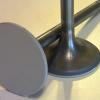

Originally Posted by
Robyn

The 6.5 has always been a problem child when it comes to keeping the temp in check in hot weather and when the rig is worked hard.
Every truck we have had here has to some extent been fussy in hot weather, even when new.
With the dual thermostats, HO water pump, modified fan clutch, and all-aluminum radiator, I finally feel comfortable when towing and no longer have to keep my eyes glued on the temperature gauge. I still have to back off the throttle some on mountain passes, but now the engine stays pretty much a constant temperature under load: right in the middle of the gauge.
Casey
1995 K1500 Tahoe 2 door, 6.5LTD, 4L80E, NP241, 3.42's, 285/75R16 BFG K02's; 1997 506 block; Kennedy OPS harness, gauges, Quick Heat plugs, and TD-Max chip; Dtech FSD on FSD Cooler; vacuum pump deleted, HX35 turbo, Turbo Master, 3.5" Kennedy exhaust, F code intake; dual t/stats, HO water pump, Champion radiator; Racor fuel filter






 Reply With Quote
Reply With Quote









